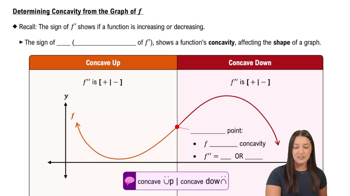Table of contents
- 0. Functions7h 52m
- Introduction to Functions16m
- Piecewise Functions10m
- Properties of Functions9m
- Common Functions1h 8m
- Transformations5m
- Combining Functions27m
- Exponent rules32m
- Exponential Functions28m
- Logarithmic Functions24m
- Properties of Logarithms34m
- Exponential & Logarithmic Equations35m
- Introduction to Trigonometric Functions38m
- Graphs of Trigonometric Functions44m
- Trigonometric Identities47m
- Inverse Trigonometric Functions48m
- 1. Limits and Continuity2h 2m
- 2. Intro to Derivatives1h 33m
- 3. Techniques of Differentiation3h 18m
- 4. Applications of Derivatives2h 38m
- 5. Graphical Applications of Derivatives6h 2m
- 6. Derivatives of Inverse, Exponential, & Logarithmic Functions2h 37m
- 7. Antiderivatives & Indefinite Integrals1h 26m
- 8. Definite Integrals3h 25m
5. Graphical Applications of Derivatives
Concavity
Problem 13d
Textbook Question
Let ƒ(x) = (x - 3) (x + 3)²
d. Determine the intervals on which ƒ is concave up or concave down.
 Verified step by step guidance
Verified step by step guidance1
First, find the second derivative of the function ƒ(x) = (x - 3)(x + 3)². Start by finding the first derivative ƒ'(x) using the product rule and the chain rule.
Next, differentiate ƒ'(x) to obtain the second derivative ƒ''(x). This will involve applying the product rule again if necessary.
Set the second derivative ƒ''(x) equal to zero to find the critical points where the concavity may change. Solve for x to find these points.
Determine the intervals created by the critical points found in the previous step. Choose test points from each interval to evaluate the sign of the second derivative ƒ''(x).
Finally, analyze the signs of ƒ''(x) in each interval: if ƒ''(x) > 0, the function is concave up; if ƒ''(x) < 0, the function is concave down.
Recommended similar problem, with video answer:
 Verified Solution
Verified SolutionThis video solution was recommended by our tutors as helpful for the problem above
Video duration:
6mPlay a video:
Was this helpful?

 6:38m
6:38mWatch next
Master Determining Concavity from the Graph of f with a bite sized video explanation from Callie
Start learningRelated Videos
Related Practice







